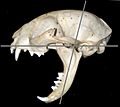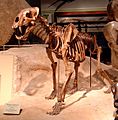Machairodontinae facts for kids
Quick facts for kids Machairodontinae |
|
|---|---|
 |
|
| A fossil skeleton of Smilodon fatalis at the National Museum of Natural History | |
| Scientific classification |
|
| Kingdom: | Animalia |
| Phylum: | Chordata |
| Class: | Mammalia |
| Order: | Carnivora |
| Suborder: | Feliformia |
| Family: | Felidae |
| Subfamily: | †Machairodontinae Gill, 1872 |
| Subgroups | |
|
|
The Machairodontinae were an amazing group of ancient cats, often called sabre-toothed cats. They were a special branch of the cat family, different from the felines (Felinae) we know today, like lions and tigers. These powerful hunters were the last group of sabre-toothed cats to exist.
They were an extinct group of mammals that belonged to the Felidae family (which includes all true cats). Sabre-toothed cats lived across many parts of the world, including Asia, Africa, North America, South America, and Europe. They roamed the Earth for a very long time, from about 23 million years ago during the Miocene period, until about 11,000 years ago in the Pleistocene period.
This group included the very famous Smilodon, also known as the sabre-toothed tiger. But there were other types of sabre-toothed cats too, like Homotherium, which had shorter, but still impressive, canine teeth. The special "sabretooth" feature developed many times in different kinds of meat-eating animals. This shows that having long, sharp teeth was a very successful way for these animals to hunt their prey by surprise.
Contents
What Were Sabre-toothed Cats?
Sabre-toothed cats were not tigers, but they were related to modern cats. They were a separate group within the cat family. Their most famous feature was their incredibly long, curved upper canine teeth. These teeth could be up to 11 inches (28 cm) long in some species!
These ancient predators were very strong and built for hunting large animals. They had powerful bodies and strong jaws. Unlike modern cats that often use a crushing bite, sabre-toothed cats used their long teeth in a different way.
Different Kinds of Sabre-toothed Cats
There were many different types of sabre-toothed cats. They are often divided into two main groups based on their teeth:
- Dirk-toothed cats: These had very long, slender, and often fragile teeth, like daggers. The most famous example is Smilodon, especially Smilodon fatalis.
- Scimitar-toothed cats: These had shorter, broader, and more curved teeth, like scimitars (curved swords). An example is Homotherium.
Some of the largest sabre-toothed cats, like Amphimachairodus giganteus, were much bigger than today's biggest cats. Imagine a cat much larger than a lion, with huge fangs!
How Sabre-toothed Cats Hunted
Scientists believe sabre-toothed cats were excellent ambush predators. This means they would hide and wait for their prey, then suddenly attack. They likely used their powerful bodies to wrestle large animals to the ground.
Their long teeth were probably used for a very precise, quick bite. They might have aimed for the throat or belly of their prey to cause a lot of damage quickly. This was different from how modern cats hunt, which often involves a crushing bite to the neck. The sabre-toothed bite was more like a shearing action, designed to cut through flesh and blood vessels.
Fossils show that sabre-toothed cats often hunted large animals like ancient bison and even young mammoths. Their hunting style needed them to be very careful with their long teeth, as they could break easily if they hit bone.
Why Did They Go Extinct?
Sabre-toothed cats lived for millions of years, but they eventually died out around 11,000 years ago. This was at the end of the last Ice Age. Many large animals, including the ones sabre-toothed cats hunted, also went extinct around this time.
Scientists think several things might have caused their extinction:
- Climate change: The end of the Ice Age brought big changes to environments.
- Loss of prey: As their main food sources disappeared, it became harder for them to find enough to eat.
- Competition: They might have faced competition from other predators, including early humans.
Even though they are gone, sabre-toothed cats remain one of the most fascinating ancient animals.
Images for kids
-
A male Amphimachairodus giganteus was one of the largest machairodonts. It dwarfs its modern relative, the common house cat, Felis catus.
-
Skull of a domestic cat, at maximum gape (80°)
-
Bison antiquus, a primary prey of Smilodon, according to isotope analysis
-
La Brea Tar Pits fauna as depicted by Charles R. Knight with two Smilodon playing the role of opportunistic scavengers.
-
A modern leopard, Panthera pardus applying the conical-tooth equivalent of the "bite and compress" to a bushbuck.
-
A sequence diagram of the shearing bite in the machairodont Homotherium serum: Diagram A depicts the machairodont pressing its lower canines and large incisors into the belly of the prey, creating a fold with the upward motion. Diagram B depicts the skull being depressed by the muscles of the neck, piercing the skin. Diagram C depicts the jaws clamped firmly around the section of skin and fat, and with incisors gripping the skin, the machairodont is pulling back, tearing the flap of skin from the belly.
See also
 In Spanish: Macairodontinos para niños
In Spanish: Macairodontinos para niños















